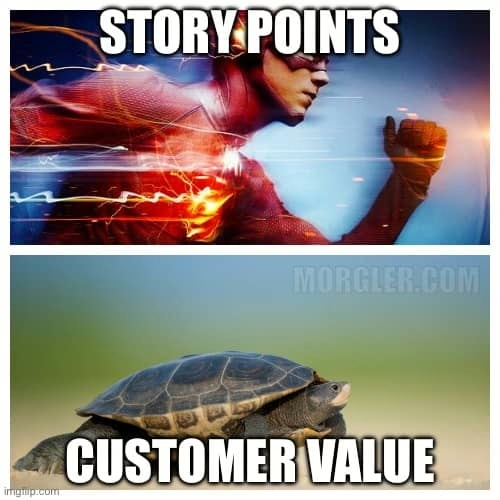“How many story points do you complete per sprint?”
“What’s your team’s velocity?”
“Why isn’t it improving?”
If you’ve heard these questions before, you know they’re usually well-intentioned – but built on a dangerous misunderstanding: the idea that velocity is a performance metric. It’s not. As soon as velocity becomes a target, it becomes useless. Goodhart’s Law in action: “When a measure becomes a target, it ceases to be a good measure.”

Velocity is internal – and should stay that way
Velocity was designed to help teams make better decisions:
- How much can we realistically take on?
- How much did we deliver last sprint?
- Where are we slowing down?
These are powerful internal reflections. But they don’t belong in management dashboards.
The moment velocity is externally evaluated – whether through targets, reports, or bonus systems – it becomes a vanity metric. Teams start inflating story points, avoiding complex work, and focusing on appearances over outcomes. Trust is lost. And so is agility.
What really matters: Outcomes, not Output
Many organizations are stuck in an output-driven mindset:
- More features = better.
- More story points = more productive.
- More hours = more committed.
But that’s a trap.
Real success lies in outcomes:
- Are we creating customer value?
- Is our product gaining traction?
- Are our people doing meaningful work?
Unfortunately, these metrics tend to be lagging indicators. They take time to reveal impact.
So instead, many managers latch onto quick, easy-to-track numbers like velocity – even when they’re meaningless.
So what actually helps?
We need better leading indicators. Not to control people, but to spark meaningful conversations.
For example:
- Defect rates
- Cycle time
- Feedback frequency
- (Yes) even how often a team laughs together – a surprisingly good sign of psychological safety and high performance
And most importantly: we need to help teams escape chronic overload.
No highway runs efficiently at 100% capacity – why should teams?
That means:
- Courageous prioritization
- Saying no
- Limiting WIP
- Slicing work into smaller, testable pieces
- Delivering value in days, not weeks
Only then can we create the kind of fast feedback loops that real agility depends on.
And what if velocity is already a target?
If velocity is already baked into KPIs and dashboards, we can’t just shout “Stop that!”
Instead, we have to ask:
Why is it being measured at all?
What need is it trying to fulfill?
Often, it’s rooted in an outdated belief: Management Theory X – the idea that people are lazy unless pushed, that productivity requires pressure, and that control equals success.
But in today’s world of knowledge work, this mindset backfires.
The real work is helping leaders rethink their assumptions. If we believe people want to contribute, to grow, and to deliver value – we don’t need to push them with artificial targets. We need to enable them.
And that’s the hard part of agile transformation – but also the most important.
Leadership needs more than frameworks
These challenges can’t be solved by methods alone. They require coaching – real, deep coaching at the leadership level.
Because most misunderstandings around metrics like velocity aren’t about tools. They’re about mindset, trust, and culture.
In my ACE program – Agile Coach Education, that’s exactly what we focus on.
It’s not just about teaching frameworks. It’s about building the coaching skills and emotional awareness to help leaders shift their view of people, power, and performance – so they can truly enable agility instead of managing it from above.
If you’re serious about building real agile culture, this is where it starts.

